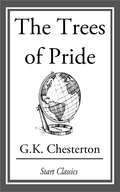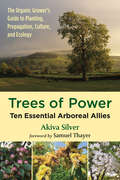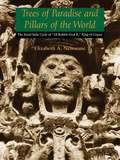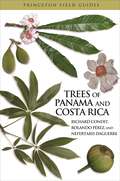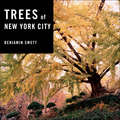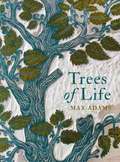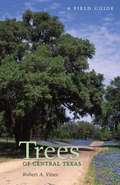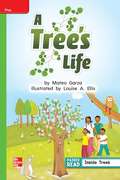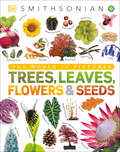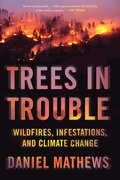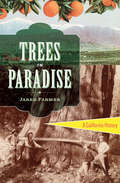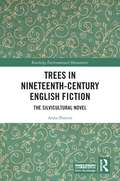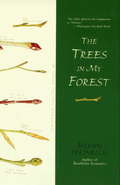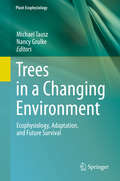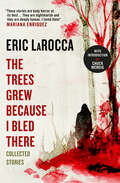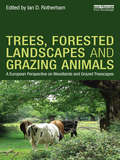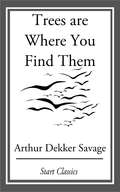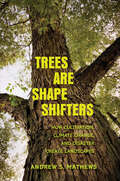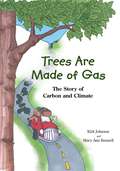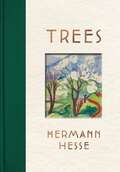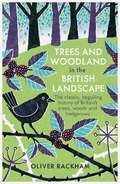- Table View
- List View
The Trees of Pride
by G. K. Chesterton"We wish you'd get rid of what you've got here, sir," he observed, digging doggedly. "Nothing'll grow right with them here." "Shrubs " said the Squire, laughing. "You don't call the peacock trees shrubs, do you? Fine tall trees -- you ought to be proud of them." "Ill weeds grow apace," observed the gardener. "Weeds can grow as houses when somebody plants them." Then he added: "Him that sowed tares in the Bible, Squire." "Oh, blast your --" began the Squire, and then replaced the more apt and alliterative word "Bible" by the general word "superstition." He was himself a robust rationalist, but he went to church to set his tenants an example. Of what, it would have puzzled him to say.
The Trees of Pride (Classics To Go)
by G. K. ChestertonThree trees, known as the Peacock trees, are blamed by the peasants for the fever that has killed many. Squire Vane scoffs at this legend as superstition. To prove them wrong, once and for all, he takes a bet to spend the night in the trees. In the morning he has vanished. Is he dead, and if so who has killed him? The poet? The lawyer? The woodsman? The trees?
Trees of Power: Ten Essential Arboreal Allies
by Akiva SilverThe organic grower's guide to planting, propagation, culture, and ecology Trees are our allies in healing the world. Partnering with trees allows us to build soil, enhance biodiversity, increase wildlife populations, grow food and medicine, and pull carbon out of the atmosphere, sequestering it in the soil. Trees of Power explains how we can work with these arboreal allies, specifically focusing on propagation, planting, and individual species. Author Akiva Silver is an enthusiastic tree grower with years of experience running his own commercial nursery. In this book he clearly explains the most important concepts necessary for success with perennial woody plants. It’s broken down into two parts: the first covering concepts and horticultural skills and the second with in-depth information on individual species. You’ll learn different ways to propagate trees: by seed, grafting, layering, or with cuttings. These time-honored techniques make it easy for anyone to increase their stock of trees, simply and inexpensively. Ten chapters focus on the specific ecology, culture, and uses of different trees, ones that are common to North America and in other temperate parts of the world: Chestnut: The Bread Tree Apples: The Magnetic Center Poplar: The Homemaker Ash: Maker of Wood Mulberry: The Giving Tree Elderberry: The Caretaker Hickory: Pillars of Life Hazelnut: The Provider Black Locust: The Restoration Tree Beech: The Root Runner Trees of Power fills an urgent need for up-to-date information on some of our most important tree species, those that have multiple benefits for humans, animals, and nature. It also provides inspiration for new generations of tree stewards and caretakers who will not only benefit themselves, but leave a lasting legacy for future generations. Trees of Power is for everyone who wants to connect with trees. It is for the survivalist, the gardener, the homesteader, the forager, the permaculturist, the environmentalist, the parent, the schoolteacher, the farmer, and anyone who feels a deep kinship with these magnificent beings.
Trees of Paradise and Pillars of the World: The Serial Stela Cycle of "18-Rabbit-God K," King of Copan
by Elizabeth A. NewsomeAssemblies of rectangular stone pillars, or stelae, fill the plazas and courts of ancient Maya cities throughout the lowlands of southern Mexico, Guatemala, Belize, and western Honduras. <P><P>Mute testimony to state rituals that linked the king's power to rule with the rhythms and renewal of time, the stelae document the ritual acts of rulers who sacrificed, danced, and experienced visionary ecstasy in connection with celebrations marking the end of major calendrical cycles. The kings' portraits are carved in relief on the main surfaces of the stones, deifying them as incarnations of the mythical trees of life.
Trees of Panama and Costa Rica (Princeton Field Guides #74)
by Richard Condit Rolando Pérez Nefertaris DaguerreThis is the first field guide dedicated to the diverse tree species of Panama and Costa Rica. Featuring close to 500 tropical tree species, Trees of Panama and Costa Rica includes superb color photos, abundant color distribution maps, and concise descriptions of key characteristics, making this guide readily accessible to botanists, biologists, and casual nature lovers alike. The invaluable introductory chapters discuss tree diversity in Central America and the basics of tree identification. Family and species accounts are treated alphabetically and describe family size, number of genera and species, floral characteristics, and relative abundance. Color distribution maps supplement the useful species descriptions, and facing-page photographic plates detail bark, leaf, flower, or fruit of the species featured. Helpful appendices contain a full glossary, a comprehensive guide to leaf forms, and a list of families not covered. The only tree guide to cover both Panama and Costa Rica together Covers almost 500 species 438 high-resolution color photos 480 color distribution maps and two general maps Concise and jargon-free descriptions of key characteristics for every species Full glossary and guide to leaf forms included
Trees of New York City
by Benjamin SwettExperience the ancient roots and enduring natural beauty of New York as never before. New York City, once a lush and verdant group of forested islands, is still home to a rich collection of diverse tree species, each with a story to tell about the city’s past. This gorgeous book by naturalist and photographer Benjamin Swett offers stunning color photographs, personal narratives, and fascinating historical observations about a select few of the thousands of trees that thrive in the five boroughs—from the sprawling New York Botanical Garden in spring bloom to the snow-laden residential blocks of Queens in winter. Swett’s warm and welcome voice adds depth and perspective to his collection, as well as an unmistakable charm unique to his city’s cosmopolitan character. The stories of these trees—some dating back to the Revolutionary era and before—link the living with the past in a visceral and engaging way that will leave readers with a renewed and lasting appreciation of their own environments. This book is a new edition to New York City of Trees.
Trees of Life
by Max AdamsAn informative, richly illustrated book about eighty of the world’s most important and remarkable treesOur planet is home to some three trillion trees—roughly four hundred for every person on Earth. In Trees of Life, Max Adams selects, from sixty thousand extant species, eighty remarkable trees through which to celebrate the richness of humanity’s relationship with trees, woods, and forests.In a sequence of informative and beautifully illustrated portraits, divided between six thematic sections, Adams investigates the trees that human cultures have found most useful across the world and ages: trees that yield timber and other materials of immense practical value, trees that bear edible fruits and nuts, trees that deliver special culinary ingredients and traditions, and trees that give us dyes, essences, and medicines. In a section titled “Supertrees,” Adams considers trees that have played a pivotal role in maintaining natural and social communities, while a final section, “Trees for the Planet,” looks at a group of trees so valuable to humanity that they must be protected at all costs from loss.From the apple to the oak, the logwood to the breadfruit, and the paper mulberry to the Dahurian larch, these are trees that offer not merely shelter, timber, and fuel but also drugs, foods, and fibers. Trees of Life presents a plethora of fascinating stories about them.
Trees of Central Texas
by Robert A. VinesA comprehensive and compact field guide, Trees of Central Texas introduces 186 species of tree life in Central Texas, an area roughly the region of the Edwards Plateau and bordered by the Balcones Escarpment on the south and east, the Pecos River on the west, and the Texas Plains and the Llano Uplift on the north. From the hardy oaks and rugged mesquites to the graceful willows, cottonwoods, and pecans, the tree life of Central Texas varies as much as the vast and changing land that hosts it. Full descriptions and superb illustrations of all the native and naturalized trees of the region as well as fascinating bits of history and lore make this an essential guide to the wealth of tree life in Central Texas. Drawn from Robert A. Vines' monumental Trees, Shrubs, and Woody Vines of the Southwest (University of Texas Press, Trees of Central Texas combines the essential detail of the larger work with the ease and convenience of a field guide. It joins in print two additional field guides by Robert Vines, both published by the University of Texas Press: Trees of East Texas and Trees of North Texas.
Trees, Leaves, Flowers and Seeds: A Visual Encyclopedia of the Plant Kingdom (DK Our World in Pictures)
by DKPacked with more than 1,000 incredible images and full of fascinating facts, this beautiful children&’s book takes you on an exciting expedition through the wonders of the plant kingdom.Have you ever wondered which plants eat insects? Or how cacti store water? How about which flowers look like bees? Or where is the tallest tree in the world? If you find yourself seeking the answers to these quirky questions and so many more, then Trees, Leaves, Flowers & Seeds may be the book for you! Explore the incredible world of plants, from the smallest seeds to the tallest trees, whilst you discover all about the weirdest, smelliest and deadliest flowers on our planet, with this engaging encyclopedia for children aged 9-12. Celebrate your child's curiosity as they explore:- Striking and detailed diagrams, drawings, and illustrations on every page - A highly visual approach to learning - An ideal combination of colorful diagrams with infographic text boxes- In association with The Smithsonian InstitutionThis captivating kids encyclopedia also takes a fun, more sideways look at some truly strange plants, such as trees with fruits like a giant&’s fingers, orchids that look like monkey faces, seeds that spin like helicopters, and trees that drip poison! The striking illustrations, photographs and diagrams featured throughout provide an optimum visual learning experience for both children and adults alike, accompanied by an array of fun facts all about your favorite flowers, plants, trees and more.This plant encyclopedia includes at-a-glance panels that provide a quick reference to all the stats, making this nature book an ideal combination of colorful diagrams and infographic text boxes. In association with DK Smithsonian, the text proves easily accessible for readers aged 9-12, yet can be enjoyed by the entire family, making this enthralling children&’s encyclopedia a beautiful and educational gift that can be passed down generations.Learn all about the world one picture at a time!If you like Trees, Leaves, Flowers & Seeds, then why not complete the collection? Part of the highly visual Our World In Pictures series, avid readers can dive into the world of dinosaurs with The Dinosaur Book, become a vehicle virtuoso with Cars, Trains, Ships and Planes and venture on a journey across the globe with Countries, Cultures, People & Places.
Trees in Trouble: Wildfires, Infestations, and Climate Change
by Daniel MathewsA troubling story of the devastating and compounding effects of climate change in the Western and Rocky Mountain states, told through in–depth reportage and conversations with ecologists, professional forest managers, park service scientists, burn boss, activists, and more. Climate change manifests in many ways across North America, but few as dramatic as the attacks on our western pine forests. In Trees in Trouble, Daniel Mathews tells the urgent story of this loss, accompanying burn crews and forest ecologists as they study the myriad risk factors and refine techniques for saving this important, limited resource.Mathews transports the reader from the exquisitely aromatic haze of ponderosa and Jeffrey pine groves to the fantastic gnarls and whorls of five–thousand–year–old bristlecone pines, from genetic test nurseries where white pine seedlings are deliberately infected with their mortal enemy to the hottest megafire sites and neighborhoods leveled by fire tornadoes or ember blizzards.Scrupulously researched, Trees in Trouble not only explores the devastating ripple effects of climate change, but also introduces us to the people devoting their lives to saving our forests. Mathews also offers hope: a new approach to managing western pine forests is underway. Trees in Trouble explores how we might succeed in sustaining our forests through the challenging transition to a new environment.
Trees in Paradise: A California History
by Jared FarmerFrom roots to canopy, a lush, verdant history of the making of California. California now has more trees than at any time since the late Pleistocene. This green landscape, however, is not the work of nature. It's the work of history. In the years after the Gold Rush, American settlers remade the California landscape, harnessing nature to their vision of the good life. Horticulturists, boosters, and civic reformers began to "improve" the bare, brown countryside, planting millions of trees to create groves, wooded suburbs, and landscaped cities. They imported the blue-green eucalypts whose tangy fragrance was thought to cure malaria. They built the lucrative "Orange Empire" on the sweet juice and thick skin of the Washington navel, an industrial fruit. They lined their streets with graceful palms to announce that they were not in the Midwest anymore. To the north the majestic coastal redwoods inspired awe and invited exploitation. A resource in the state, the durable heartwood of these timeless giants became infrastructure, transformed by the saw teeth of American enterprise. By 1900 timber firms owned the entire redwood forest; by 1950 they had clear-cut almost all of the old-growth trees. In time California's new landscape proved to be no paradise: the eucalypts in the Berkeley hills exploded in fire; the orange groves near Riverside froze on cold nights; Los Angeles's palms harbored rats and dropped heavy fronds on the streets below. Disease, infestation, and development all spelled decline for these nonnative evergreens. In the north, however, a new forest of second-growth redwood took root, nurtured by protective laws and sustainable harvesting. Today there are more California redwoods than there were a century ago. Rich in character and story, Trees in Paradise is a dazzling narrative that offers an insightful, new perspective on the history of the Golden State and the American West.
Trees in Nineteenth-Century English Fiction: The Silvicultural Novel (Routledge Environmental Humanities)
by Anna BurtonThis is a book about a longstanding network of writers and writings that celebrate the aesthetic, socio-political, scientific, ecological, geographical, and historical value of trees and tree spaces in the landscape; and it is a study of the effect of this tree-writing upon the novel form in the long nineteenth century. Trees in Nineteenth-Century English Fiction: The Silvicultural Novel identifies the picturesque thinker William Gilpin as a significant influence in this literary and environmental tradition. Remarks on Forest Scenery (1791) is formed by Gilpin’s own observations of trees, forests, and his New Forest home specifically; but it is also the product of tree-stories collected from ‘travellers and historians’ that came before him. This study tracks the impact of this accumulating arboreal discourse upon nineteenth-century environmental writers such as John Claudius Loudon, Jacob George Strutt, William Howitt, and Mary Roberts, and its influence on varied dialogues surrounding natural history, agriculture, landscaping, deforestation, and public health. Building upon this concept of an ongoing silvicultural discussion, the monograph examines how novelists in the realist mode engage with this discourse and use their understanding of arboreal space and its cultural worth in order to transform their own fictional environments. Through their novelistic framing of single trees, clumps, forests, ancient woodlands, and man-made plantations, Jane Austen, Elizabeth Gaskell, and Thomas Hardy feature as authors of particular interest. Collectively, in their environmental representations, these novelists engage with a broad range of silvicultural conversation in their writing of space at the beginning, middle, and end of the nineteenth century. This book will be of great interest to students, researchers, and academics working in the environmental humanities, long nineteenth-century literature, nature writing and environmental literature, environmental history, ecocriticism, and literature and science scholarship.
The Trees in My Forest
by Bernd HeinrichIna book destined to become a classic, biologist and acclaimed nature writer Bernd Heinrich takes readers on an eye-opening journey through the hidden life of a forest.
Trees in a Changing Environment
by Michael Tausz Nancy GrulkeThis book delivers current state-of-the-science knowledge of tree ecophysiology, with particular emphasis on adaptation to a novel future physical and chemical environment. Unlike the focus of most books on the topic, this considers air chemistry changes (O3, NOx, and N deposition) in addition to elevated CO2 effects and its secondary effects of elevated temperature. The authors have addressed two systems essential for plant life: water handling capacity from the perspective of water transport; the coupling of xylem and phloem water potential and flow; water and nutrition uptake via likely changes in mycorrhizal relationships; control of water loss via stomata and its retention via cellular regulation; and within plant carbon dynamics from the perspective of environmental limitations to growth, allocation to defences, and changes in partitioning to respiration. The authors offer expert knowledge and insight to develop likely outcomes within the context of many unknowns. We offer this comprehensive analysis of tree responses and their capacity to respond to environmental changes to provide a better insight in understanding likelihood for survival, as well as planning for the future with long-lived, stationary organisms adapted to the past: trees.
The Trees Grew Because I Bled There: Collected Stories
by Eric LaRoccaA beautifully crafted, devastating short fiction collection from the Bram-Stoker finalist and author of Things Have Gotten Worse Since We Last Spoke and Other Misfortunes. Includes an introduction from acclaimed bestselling author Chuck Wendig.Eight stories of literary dark fiction from a master storyteller. Exploring the shadow side of love, these are tales of grief, obsession, control. Intricate examinations of trauma and tragedy in raw, poetic prose. In these narratives, a woman imagines horrific scenarios whilst caring for her infant niece; on-line posts chronicle a cancer diagnosis; a couple in the park with their small child encounter a stranger with horrific consequences; a toxic relationship reaches a terrifying resolution…Originally published under the title The Strange Thing We Become and Other Dark Tales, this is a much-praised collection of deeply unsettling, painfully dark tales.
Trees, Forested Landscapes and Grazing Animals: A European Perspective on Woodlands and Grazed Treescapes
by Ian D. RotherhamIn this comprehensive book, the critical components of the European landscape – forest, parkland, and other grazed landscapes with trees are addressed. The book considers the history of grazed treed landscapes, of large grazing herbivores in Europe, and the implications of the past in shaping our environment today and in the future. Debates on the types of anciently grazed landscapes in Europe, and what they tell us about past and present ecology, have been especially topical and controversial recently. This treatment brings the current discussions and the latest research to a much wider audience. The book breaks new ground in broadening the scope of wood-pasture and woodland research to address sites and ecologies that have previously been overlooked but which hold potential keys to understanding landscape dynamics. Eminent contributors, including Oliver Rackham and Frans Vera, present a text which addresses the importance of history in understanding the past landscape, and the relevance of historical ecology and landscape studies in providing a future vision.
Trees are Where You Find Them
by Arthur Dekker SavageThe trees on Mars are few and stunted, says old Doc Yoris. There's plenty of gold, of course--but trees can be much more important!
Trees Are Shape Shifters: How Cultivation, Climate Change, and Disaster Create Landscapes (Yale Agrarian Studies Series)
by Andrew S. MathewsAn exploration of the anthropogenic landscapes of Lucca, Italy, and how its people understand social and environmental change through cultivation In Italy and around the Mediterranean, almost every stone, every tree, and every hillside show traces of human activities. Situating climate change within the context of the Anthropocene, Andrew Mathews investigates how people in Lucca, Italy, make sense of social and environmental change by caring for the morphologies of trees and landscapes. He analyzes how people encounter climate change, not by thinking and talking about climate, but by caring for the environments around them. Maintaining landscape stability by caring for the forms of trees, rivers, and hillsides is a way that people link their experiences to the past and to larger scale political questions. The human-transformed landscapes of Italy are a harbinger of the experiences that all of us are likely to face, and addressing these disasters will call upon all of us to think about the human and natural histories of the landscapes we live in.
Trees Are Made Of Gas: The Story of Carbon and Climate
by Kirk JohnsonSee-oh-too is an influential guy. Trees Are Made of Gas teaches young readers all about carbon dioxide, an invisible, odorless gas that is essential for plant growth—but is also responsible for global climate change. Kids learn both the science and impact of the massive release of carbon dioxide into the atmosphere, making a clear argument for conservation and clean up. Providing simple explanations along with ways to reduce your own carbon footprint, this engaging book is sure to engage young environmentalists.
Trees: An Anthology of Writings and Paintings
by Hermann HesseAn elegant collection of Hermann Hesse’s essays, poems, and passages on the subject of trees and nature, accompanied by thirty-one of his watercolor illustrations. Hermann Hesse understood trees to be symbols of transcendence and rebirth, of instinctive growth present in all natural life. This elegant collection of his essays, poems, and passages on trees, accompanied by thirty-one of his watercolor illustrations, reveals his inspired thoughts on nature, spirituality, and self-knowledge. Together, his writings and paintings mirror the seasons and landscapes as he experienced them, and help remind us that trees’ annual rings are representations of our own days’ struggle, happiness, and purpose. In the author’s words: “They struggle with all the force of their lives for one thing only: to fulfill themselves according to their own laws . . . Whoever has learned to listen to trees no longer wants to be one. He wants to be nothing except who he is.”
Trees and Woodland in the South Yorkshire Landscape: A Natural, Economic & Social History
by Melvyn JonesIf you stop and look around you will see trees everywhere: not only in woods and plantations, in parks and gardens and in hedges but also along streets, beside motorways, on old colliery sites, around reservoirs, in the centre of villages and larger urban settlements and standing alone or in small groups in such diverse places as churchyards, in the middle of fields or on high moorlands.This authoritative and copiously illustrated book guides the reader to an understanding of the natural, economic and social history of the woodlands, semi-natural and planted, and the trees, native and introduced, that grace the South Yorkshire landscape and give it much of its beauty and character.
Trees and Woodland in the British Landscape
by Dr Oliver RackhamA beautifully written classic of nature writing.'A masterly account...of supreme interest...a classic' Country LifeLong accepted as the best work on the subject, Oliver Rackham's book is both a comprehensive history of Britain's woodland and a field-work guide that presents trees individually and as part of the landscape.From prehistoric times, through the Roman period and into the Middle Ages, Oliver Rackham describes the changing character, role and history of trees and woodland. He concludes this definitive study with a section on the conservation and future of Britain's trees, woodlands and hedgerows.
Trees and Woodland in the British Landscape
by Oliver RackhamA beautifully written classic of nature writing.'A masterly account...of supreme interest...a classic' Country LifeLong accepted as the best work on the subject, Oliver Rackham's book is both a comprehensive history of Britain's woodland and a field-work guide that presents trees individually and as part of the landscape.From prehistoric times, through the Roman period and into the Middle Ages, Oliver Rackham describes the changing character, role and history of trees and woodland. He concludes this definitive study with a section on the conservation and future of Britain's trees, woodlands and hedgerows.
Trees and Weather
by Lawrence Hall of Science University of California at BerkeleyNIMAC-sourced textbook
